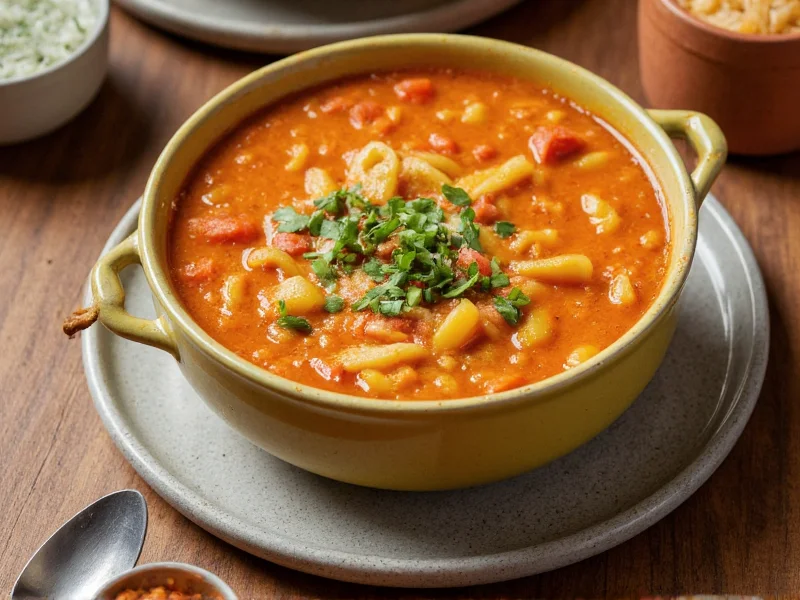When travelers seek authentic culinary experiences, destination soups provide a flavorful gateway to understanding regional cultures. These traditional regional soups around the world tell stories of local agriculture, historical influences, and community traditions through carefully crafted broths, distinctive ingredients, and time-honored preparation methods. Unlike generic soup recipes, destination soups embody the spirit of their places of origin, making them essential components of cultural exploration through food.
The Cultural Significance of Soup in Global Cuisines
Soup represents one of humanity's oldest culinary traditions, with archaeological evidence of soup-making dating back 20,000 years. Across continents, these nourishing broths evolved as practical solutions for utilizing available ingredients while providing warmth and sustenance. What transforms ordinary soup into a destination soup is its deep connection to a specific place's identity—whether it's the saffron-infused bouillabaisse of Marseille reflecting Mediterranean fishing traditions or the complex spice layers of Thailand's tom yum soup showcasing tropical botanicals.
The cultural significance of destination soups extends beyond mere nourishment. In many societies, these traditional dishes serve as culinary anchors during celebrations, religious observances, and seasonal transitions. Japanese miso soup accompanies nearly every meal as a symbol of harmony, while Poland's hearty żurek soup marks Easter celebrations with its distinctive sour rye base. Understanding these connections enriches travel experiences, allowing visitors to participate in living food traditions rather than merely observing them.
Iconic Destination Soups Around the World
| Region | Signature Soup | Key Ingredients | Cultural Significance |
|---|---|---|---|
| East Asia | Miso soup (Japan) | Fermented soybean paste, dashi broth, tofu, seaweed | Daily staple representing Japanese culinary philosophy of balance |
| Western Europe | French onion soup | Caramelized onions, beef broth, baguette, melted cheese | Parisian bistro classic with origins dating to Roman times |
| Mediterranean | Bouillabaisse (France) | Local Mediterranean fish, saffron, fennel, olive oil | Traditional Provençal fisherman's stew with protected designation |
| Middle East | Shorbat adas (Lebanon) | Lentils, cumin, lemon, olive oil | Symbol of hospitality served during Ramadan and celebrations |
| Latin America | Caldo de pollo (Mexico) | Chicken, vegetables, epazote, handmade tortillas | Comfort food representing Mexican home cooking traditions |
How Destination Soups Reflect Local Terroir and Traditions
The ingredients in authentic destination soups directly mirror their geographical origins. Thailand's tom kha gai features coconut milk and galangal that thrive in tropical climates, while Russia's borscht incorporates beets that flourish in Eastern European soil. These traditional soup recipes from global destinations evolved through necessity—using seasonal, locally available ingredients that could be preserved through fermentation or drying for winter months.
Historical trade routes also shaped many destination soups. The introduction of tomatoes to Europe transformed Italian minestrone, while the Columbian Exchange brought potatoes to Ireland, creating the foundation for Irish potato soup. When travelers encounter these dishes in their places of origin, they experience culinary history in a bowl—understanding how migration, colonization, and cultural exchange influenced regional foodways.
Experiencing Destination Soups Authentically While Traveling
For travelers seeking genuine culinary experiences, identifying authentic destination soups requires attention to detail. Look for establishments where soup preparation follows traditional methods—like the Marseille fishmongers who still sort catch specifically for bouillabaisse. The best regional soups to try when traveling often come from family-run establishments rather than tourist-focused restaurants, where recipes have been passed down through generations.
Seasonality matters significantly when experiencing destination soups. Japan's zōni soup changes ingredients based on regional New Year traditions, while Germany's eisbein soup features ingredients appropriate for cold winter months. Asking locals about seasonal soup specialties often leads to the most authentic travel food experiences, as these dishes connect directly to agricultural cycles and cultural calendars.
Preserving Culinary Heritage Through Destination Soups
As globalization threatens regional food traditions, destination soups serve as important cultural preservation tools. Organizations like UNESCO now recognize certain culinary traditions as intangible cultural heritage, including elements of soup-making traditions. Chefs and home cooks worldwide are documenting traditional soup recipes from global destinations to prevent culinary knowledge from disappearing.
Travelers contribute to this preservation simply by seeking authentic experiences and showing appreciation for traditional preparation methods. When visitors understand that Mexico's pozole requires hours of slow-cooking hominy and that Korean sundubu jjigae uses handmade tofu, they help sustain these culinary traditions through informed appreciation rather than treating them as exotic novelties.
Bringing Destination Soup Experiences Home
While nothing replaces tasting destination soups in their places of origin, home cooks can honor these traditions through respectful recreation. Start with authentic ingredients—imported miso paste for Japanese soup or proper saffron for bouillabaisse. Understanding the cultural context behind each dish transforms simple soup-making into a meaningful culinary journey.
When recreating traditional regional soups around the world, focus on technique as much as ingredients. The slow caramelization of onions for French onion soup or the careful layering of spices in Moroccan harira soup requires patience that mirrors the cultural values of their places of origin. These cooking processes become meditative connections to distant culinary traditions.
Conclusion: The Journey in Every Bowl
Destination soups offer more than nourishment—they provide edible passports to understanding global cultures. Each spoonful tells a story of geography, history, and community that transforms casual travelers into informed cultural participants. By seeking out and respecting these culinary traditions, travelers gain deeper connections to the places they visit while supporting the preservation of valuable food heritage. Whether savoring steaming pho in Hanoi or hearty gumbo in New Orleans, destination soups remain among the most accessible and meaningful ways to experience the authentic spirit of a place through its most comforting culinary tradition.











 浙公网安备
33010002000092号
浙公网安备
33010002000092号 浙B2-20120091-4
浙B2-20120091-4